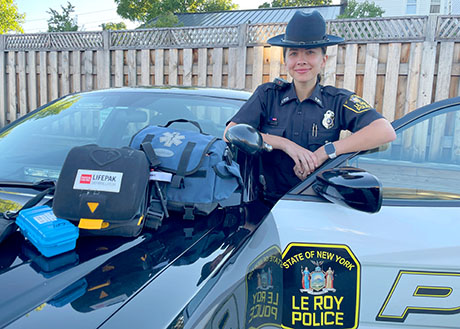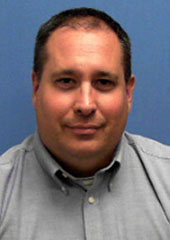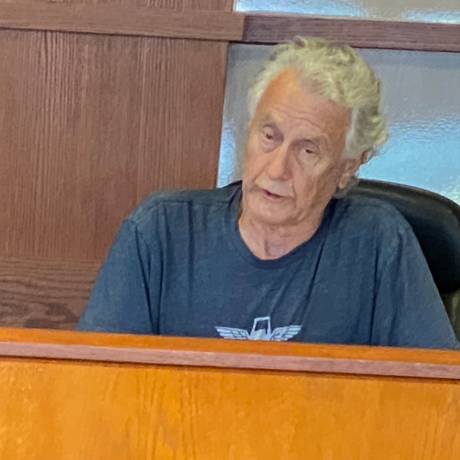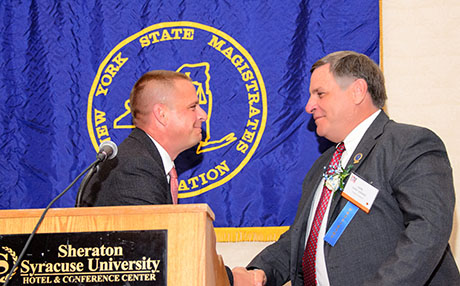Musical memories: from vinyl to TV to the real thing
Listen To The Music (What the people need is a way to make them smile ... The Doobie Brothers)
Throughout my life music has been both a source of joy and a cause for regret. On thr positive side, I listen to or watch music every single day. It is one of the things I absolutely have to have in my life and I find it hard to imagine being without it. Going to see and hear live music is something I do all of the time, and I really missed it through the two years of the pandemic.
However, I constantly regret not ever learning to play an instrument and reading music. Like a lot of other things I didn’t do in my life, it was a result of shyness and insecurity mixed in with the lack of available resources. In elementary school (St. Mary’s) and high school (Notre Dame) we had no instrumental music instruction at all.
My brother Dan was a member of St. Joseph’s Drum Corps, and I was too shy to join. As an example of my reticence, when I was 9 or 10 my mother signed me up for swimming lessons at Godfrey’s Pond. When the time came to go, I hid in the closet, and she had to threaten to call the priest to get me out of there. Of course, once she got me there, I was fine and loved swimming.
When I think about being a little kid, I really don’t recall much about music then. I was more interested in sports: I can remember a football game I watched on TV in 1954 when I was 7. My parents, like everyone from the World War II era, loved Big Band music, so I probably heard some of that on the radio. My Aunts Kate and Peg wouldn’t miss “The Lawrence Welk Show” every Saturday night, but a kid wouldn’t admit to their friends that they watched that. Every weekday morning my mom had on the “Clint Buehlman Show” (“yours truly Buehly”) on WBEN Buffalo while we ate breakfast and got ready for school. But he was an avowed rock and roll hater and wouldn’t play any of that “noise.”
Vinyl Countdown
Eventually, I did start listening to some of the DJs, and I distinctly remember the first two records I ever bought. The first was “Singing The Blues” by Guy Mitchell in 1956, and then “Come Go With Me” by the Dell Vikings in 1957. I think they might have been 78 RPM records, but I’m not positive. The former was kind of country-ish and the latter was “Doo-Wop,” so I think my mom didn’t complain too much when I played them on our very basic record player.

A Christmas present which really made a big impression in my music life was a little red transistor radio with an earphone I got when I was 12 or 13. Up until then I had to share the family radio with my parents. The transistor meant I could listen to whatever I wanted, whenever I wanted. And I could plug the earphone in and only I could hear what was being played.
At that time in the early '60s, WKBW 1520 on the AM dial from Buffalo was getting a reputation as a powerhouse of rock and roll broadcasting. DJs Tommy Shannon, Joey Reynolds, and Danny Neaverth were all “spinning the hits” for a wide audience, which definitely included me.
Tommy Shannon was one of the early cool DJ's who drove a Corvette and reputedly dated Ann Margaret. He wrote his own theme song which I'd bet many people could still sing today: “Top tunes ... news and weather. So glad we could ... get together. On the ... Tom Shannon show.” The group Rockin' Rebels did an instrumental version that became a top 10 hit in 1961.
Joey Reynolds (real name Joey Pinto), in between playing songs, was an early predecessor to “shock jocks” like Howard Stern. He would break records he didn't like, argue with callers, and just generally adopted an over-the-top persona. When he eventually got fired, he nailed his shoes to the station manager's door with a note that said, “Fill these!”
Danny Neaverth was a home town Buffalo boy who was on WKBW for 25 years. He made appearances at local schools including one time at a Notre Dame dance that I attended. At one point he asked for a volunteer to come up on stage, and I was too shy, but my “friends “ volunteered me by carrying me to the stage and dumping me up there. I don't recall what I had to do, but I'm sure my blushing face was as scarlet as a fire truck. Neaverth was also the public address announcer for the Buffalo Bills football and Braves basketball teams.
Regardless of their radio personalities, it was mostly these three DJ's who introduced me to Dion and The Belmonts, the Shirelles, the Beach Boys, and eventually to the English explosion of the Beatles, Dave Clark 5 and the Rolling Stones.
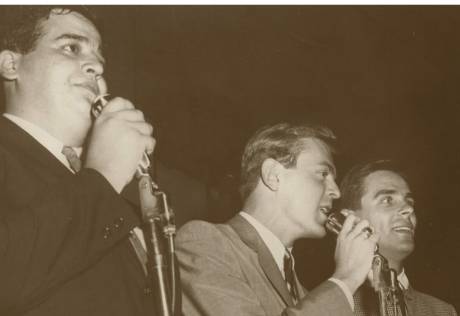
(L to R) Joey Reynolds, Tommy Shannon, and Danny Neaverth of WKBW 1520
Television Tunes
As far as seeing bands, the best place to do that was on “The Ed Sullivan Show” on TV. Of course, there was the infamous Elvis Presley swivel-hipped debut in 1956. Buddy Holly, The Four Seasons, and The Beach Boys all had appearances leading up to the debut of the Beatles in February 1964. I had just turned 17 and was in my senior year at Notre Dame, and I was watching with millions of others. My biggest memory of the show was an audience of screaming teenage girls who seemed to be having, in the words of “The Count Five” song a couple years later, “a psychotic reaction.” (As a side note, that crowd craziness was what caused the Beatles to give up playing live.)
There was also “American Bandstand” with Dick Clark. I think more girls watched that for the dancing. Plus, the songs were lip synced, not live. A funny part to me was when they'd choose a boy and a girl from the audience to rate a record. Practically every time one would say, “Dick, I'll give it a 10 because it's got a good beat to dance to.”
Then, in college years, there were two shows called “Shindig” and “Hullabaloo.” They had on all the famous bands (plus go-go dancers). Back then in college, no one had a TV in their dorm room; there was one in the lounge, but hardly anyone ever watched it except for when those shows came on. Then the room was packed.
Going Live
As far as actually seeing live music in person, we were pretty much limited to local teenage bands like Batavia High's Cryin' Strings in the basement of St. Mary's Church, or at school dances, due to not being old enough to drive. I have a friend I met in college who went to Toronto in 1964 and 1965 when she was in high school to see the Beatles, but that was way out of my league. She probably still suffers vocal chord problems from it.
In June 1964, though, a rock and roll show actually came to Batavia at the Mancuso Theater, and I wasn't going to miss that. I don't remember who I went with, but I'm hoping it was a girl. I did have a sort of girlfriend my senior year, but since I didn't have a driver's license or a car, I was lucky she tolerated me.
The headliners were The Searchers from England. Part of the “British Invasion,” they had a couple of hits with “Needles and Pins” and “Love Potion #9.” I remember thinking at the time, “Wow. A real English band in Batavia.” In doing some research for this story I heard from a woman (a young teenage girl then, of course) who said that she and some of her friends talked their way onto the tour bus and she kissed the drummer. There's a memory to last a lifetime! I bet she wishes “selfies” was a thing then.
Other bands on the bill were Ronnie Dio and The Prophets. I don't remember them, but years later he became the guitarist for Black Sabbath, The Dovells (a choreographed dancing boy band who had a hit with “Bristol Stomp”), and Dick and Dee Dee who sang “River Deep, Mountain High.” I was surprised to find out Dick had the high falsetto voice. There were two shows and five bands, so some of the groups must have done only two or three songs. It was emceed by Danny Neaverth, who seemed to be everywhere back then. I wouldn't put it anywhere in the top shows I've seen, but it's memorable for being the first.

The event that really turned things around for my music experience was going to college. In September 1964, I was off to St. John Fisher College (now University) in Rochester. Between the guys in the dorm and the girls at Nazareth just down the road, I became exposed to a lot of different tastes and genres. Eventually, between the two schools and being in Rochester, I got to see a lot of bands and groups. Nazareth had an especially nice theater which hosted some great shows.
When I came back home for the summer, Batavia really didn't have any national touring band venues, but about 15 miles north on Route 98 in Albion there was the Oak Orchard Lanes. For most of the week it was a bowling alley, and on weekends they covered the lanes with plywood and set up a stage and sound system. I didn't have a car yet, so I had to ride with friends who drove way too fast. Closing my eyes and gritting my teeth all the way there and back, I always thought it was worth it to see good bands.
Some of the groups I remember seeing there were The Association (“Cherish” and “Windy”), Shadows Of The Knight (“Gloria”), Los Bravos (“Black Is Black”) and the Swinging Medallions (there's a '60s name for you) which had a hit with “Double Shot Of My Baby's Love.”
There was a band from Toronto called The Mandala and dressed in gangster-styled suits and used strobe lights which I had never seen before. They had a minor U.S. hit with “ Love–itis.” All in all, no really long-lasting famous bands, but it was something to do and some pretty decent music. When I was researching this part of my story, a lady named Gail who used to frequent “The Lanes” back then had been there recently and took some photos that she shared.

Photo courtesy of Gail Williams
Burn Baby Burn
Another summer college destination was The Inferno, a big venue in Williamsville east of Buffalo. The main draw for going there was the weekly appearance of Wilmer Alexander and the Dukes. Wilmer was a black R&B singer from Geneva, fronting an all-white band. Immensely popular in the Western NY area, The Dukes drew sellout audiences wherever they played, with their signature crowd pleaser being a cover of The Four Tops’ “Reach Out.”
I also recall seeing Junior Walker and the All Stars there doing “Shotgun” and “Road Runner.” The night I saw the Paul Butterfield Blues Band, I was standing in the back watching an opening act, and glanced to my side and Butterfield was standing next to me in all of his black-leather-jacketed glory. What did I say to him? Well, it was me, so I just stood there pretending I didn't see him until he walked away. Again, an iPhone 13 would have come in handy.
Ironically, I was kind of a soul music/R&B fan at that point in the summer of 1967, and it was at that venue where soul was king that I had an experience that changed my whole musical taste. In addition to the main room at the Inferno, there was a another glass-enclosed smaller room which featured a second act. One night I didn't care for who was playing in the big room and decided to check out a band called Salvation Navy. I don't know who they were or where they were from, but the music they were playing blew me away.
That May the Beatles had released “Sgt. Pepper's Lonely Hearts Club Band.” I was somewhat of a Beatles fan (who wasn't?), but hadn't seriously listened to that album yet. Well, the Salvation Navy, whoever they were, played that album note for note and chord for chord, and I don't see how the Beatles could have played it live any better themselves. I was entranced, and from then on my head went in a whole different direction in my musical taste.
Unfortunately in September 1968, The Inferno lived up to its name and burned to the ground, ending its several year reign as a go-to music venue.
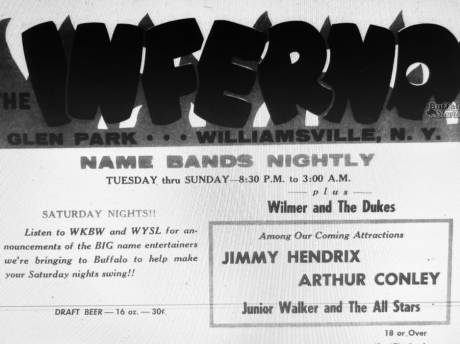
A local Batavia spot I should mention — although most went there for the girls and drinking rather than the music — was Columbo's Clinton Lounge on Clinton Street Road. It was definitely misnamed, because you wouldn't go there to actually “lounge” or even drink out of a glass. But on Saturday nights, they regularly had a band from Rochester called King Arthur And The Knights. My clearest memory of them is the cover they did of The Four Seasons' “Can't Take My Eyes Off Of You,” which was great for some serious slow dancing with a certain girl.
In my final couple of years of college, and with getting a car, I really began to see a lot of big time bands, both in Rochester and elsewhere. After graduation I kept up my love of going to live music all through the '70s until the '80s when I had children. There were few shows in the next 20 years, but most of my time was taken up with child- centered activities, particularly softball.
When the kids got old enough to “fly from the nest,” and especially when I retired from a 33-year teaching career, I resumed going to concerts in earnest. I certainly don't pay $3-$5 for a ticket any more, like in the old days, but it's worth it to me to be entertained. It's also different than attending sporting events, because you don't leave sad if your team loses.
In recent years I have also become a poster and ticket collector of concerts that I have attended, and my apartment looks like a mini rock and roll hall of fame. It's fun to look back all those years ago and remember how my love of music started and developed, and grew into something that gives me so much happiness today.
I just keep asking myself one question though: why couldn't my mother have broken out the priest threat to get me to take music lessons instead of swimming?












